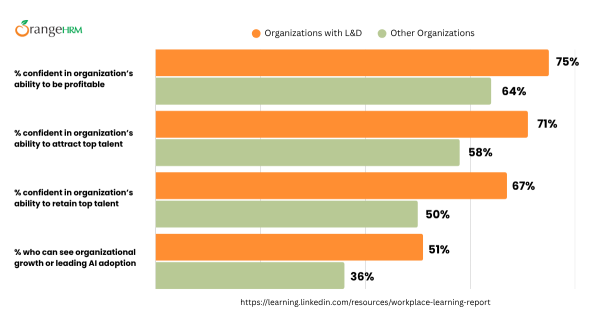I. The New Mandate: Why L&D is a Business Survival Skill
The question of whether your training strategy is fit for the future is no longer about budget; it's about business survival. Rapid technological advancements, primarily driven by AI, have dramatically shortened the half-life of skills. What was once a 'nice-to-have' employee perk is now the primary engine of organizational resilience—a concept known as skills agility.
The traditional L&D model—a decentralized function focused on mandatory compliance and generic skill programs—is fundamentally broken when faced with this pace of change. Executives and L&D leaders now understand that learning must directly contribute to the bottom line, or it fails.
The Strategic Imperative: Aligning Learning with Business Goals
According to the LinkedIn 2024 Workplace Learning Report, the mandate for L&D has never been clearer. For the second consecutive year, the top priority is deeply strategic, signaling a permanent shift in focus.
The visualization below captures the top concerns for L&D professionals, showing an undeniable focus on business alignment and talent outcomes:
|
L&D Priority |
Rank (2024) |
Key Business Impact |
|
Aligning learning programs to business goals |
#1 |
Strategic relevance, budget justification |
|
#2 |
Building skills agility, closing gaps |
|
|
Creating a culture of learning |
#3 |
Fostering adaptability and innovation |
|
Helping employees develop their careers |
#4 (Up from #9) |
Employee retention strategy, talent mobility |
|
Improving employee retention |
#5 |
Reducing turnover costs |
Source: LinkedIn 2024 Workplace Learning Report.
The most significant movement in this data is the leap of "Helping employees develop their careers" from the ninth to the fourth position. This single shift is the answer to the central question: a future-proof L&D strategy cannot exist without a robust career-driven learning component. Employees are no longer satisfied with generic course catalogs; they demand a clear, personalized path for progress.
II. The Core Challenge: Trading Off Speed, Depth, and Engagement (H2)
To successfully implement a future-proof L&D strategy, leaders must navigate several critical and often conflicting trade-offs. The failure to reconcile these factors is what often leaves organizations stuck with training programs that are either too slow, irrelevant, or simply ignored.
Tradeoff 1: Strategic Alignment vs. Speed-to-Delivery (H3)
The need for speed—getting employees the right skills now—often clashes with the requirement for deep, strategic planning.
-
The Challenge: A sudden market change (like the advent of Generative AI) requires immediate, rapid-response training. The traditional process of conducting a thorough skills gap analysis, developing custom content, and deploying a full curriculum takes months.
-
The Trade-off: Do you deploy a fast, generic, "good enough" program that buys you time, or do you wait for a perfect, deeply customized solution that aligns perfectly with business goals but risks obsolescence before launch?
The report hints at the scale of this problem: most expensive, large-scale reskilling initiatives remain stalled in the planning stages, failing to advance enough to measure success.
Tradeoff 2: Personalization vs. Scale and Efficiency (H3)
Employees crave learning that directly addresses their career goals and current skill gaps. This is the personalized learning pathways model.
-
The Challenge: Personalized learning is powerful but traditionally resource-intensive. Mapping every employee's current skill profile against hundreds of potential future roles and curating unique content paths for them requires technology that most L&D departments lack.
-
The Trade-off: Do you serve the many with generic, scalable compliance and foundational training (efficient, low engagement) or do you serve the few with deep, individualized coaching and development (high engagement, high cost)?
The Answer Lies in Motivation: The Power of Career Goals (H3)
The key to resolving the personalization vs. scale trade-off is to leverage the employee’s intrinsic motivation. Learning is not something you force onto an employee; it's something you enable them to pursue.
-
Report Insight: Employees are highly motivated to learn when they see a clear line of sight to professional advancement.
|
Learner Engagement Trigger |
Impact on Learning Engagement |
|
Learners who set career goals |
Engage with learning FOUR TIMES more than those who don't. |
|
People who crave AI skills |
4 in 5 want to learn more on how to use AI in their profession. |
Source: LinkedIn 2024 Workplace Learning Report.
This data is crucial: by shifting the design of training from mandatory course assignments to personalized learning pathways linked to visible internal mobility opportunities, L&D unlocks engagement at scale. The company benefits from skills agility, and the employee benefits from career growth. This synergy forms the basis of a sustainable employee retention strategy.
The fundamental challenge in implementing a skills-first strategy is that the necessary data—employee performance, career interests, skill gaps, and learning consumption—is scattered across disconnected systems (LMS, Performance, Talent, HRIS).
A unified HR platform, such as OrangeHRM, is not just an administrative tool; it is the integrated HR platform required to achieve skills agility and solve the trade-offs discussed earlier. It provides the single source of truth for all talent data, enabling strategic, data-driven decisions that follow Google's MUM model for comprehensive analysis.
The Role of an Integrated System (H3)
-
Automated Skills Gap Analysis: The system must use job profiles and performance data to automatically identify current skills deficits and future skill needs for every employee.
-
Driving Career-Driven Learning: The platform links the Career Development module directly to the Training Module. When an employee sets a goal to move into a new role (e.g., Senior Analyst), the system generates the precise, customized learning path required to close that gap.
-
Measuring True L&D ROI: This is the most critical function. An integrated platform can connect the dots to prove the value of learning. It correlates:
-
Training Completion → Performance Review Scores (showing skill application).
-
Skill Acquisition → Internal Mobility Rate (showing career progression).
-
Learning Engagement → Employee Retention Rate (showing loyalty and belonging).
-
The Challenge of Measuring Impact (H3)
Currently, L&D professionals struggle to deliver clear ROI because their tools are fragmented. The data below shows what L&D professionals are using today to measure business impact—metrics that are far easier to track with an integrated system:
|
Top 3 Metrics Used to Track L&D Business Impact |
Percentage of L&D Pros Tracking |
|
Performance Reviews |
36% |
|
Employee productivity |
34% |
|
Employee retention |
31% |
Source: LinkedIn 2024 Workplace Learning Report.
Only by connecting these data points in a single integrated HR platform can an organization move from anecdotal evidence to a definitive proof of L&D ROI.
IV. The Ultimate Payoff: Retention, Agility, and Growth (H2)
The successful adoption of a skills-first strategy using a unified platform delivers quantifiable benefits, transforming the L&D function into a true partner for business growth.
The Business Case for a Learning Culture (H3)
The evidence is overwhelming: a strong commitment to learning pays off in core talent metrics. Organizations that prioritize learning and development outperform their peers across the board.
|
Talent Metric |
Improvement in Companies with Strong Learning Cultures |
|
Employee Retention |
57% Higher Retention Rate |
|
Internal Mobility |
23% Higher Internal Mobility Rate |
|
Management Pipeline |
7% Higher Promotions to Management |
Source: LinkedIn 2024 Workplace Learning Report.
This data confirms that the best employee retention strategy is not a higher salary; it's a visible, credible path for growth. OrangeHRM’s integrated modules (Performance, Training, Career Development) work in concert to build and sustain this learning culture.
Final Tradeoff: Reactive vs. Proactive HR (H3)
The last choice for HR leaders is the strategic path: remain a reactive administrative function that struggles to fill skill gaps as they appear, or become a proactive, data-driven partner that anticipates future workforce needs. A future-proof L&D strategy demands the latter. By adopting a modern, integrated platform, organizations gain the visibility to make strategic talent investments, ensuring their workforce is prepared to meet the demands of tomorrow.
